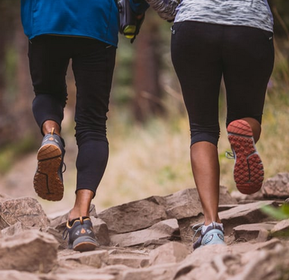 Getting bored with flat pavement? If so, now’s the time to change up your running routine by finding trails near your home and on your travels. Even if it’s just once a week, running off-road can stave off boredom and help you get stronger. Uneven surfaces make you engage your core and lateral stabilizing muscles. Groomed trails that are wide and mostly level make for a great introduction to running off the road. The opposite of that are narrow dirt trails with a variety of obstacles such as tree roots, rocks, sand, hills, and more. When you first start out, it’s important to avoid comparing your trail pace to your normal road-running pace. Naturally it will be slower on tougher terrain, and that’s OK. Purposely slow your pace and develop a trail tempo. Staying sprain-free is key if you want to make trail running your hobby, regular conditioning, or weekly off-day. When you’re ready to pound some terra firma instead of pavement, these helpful tips from Runner’s World and REI can help reduce the risk of injury: Adopt good posture. Shortening your stride can make you more agile and able to react quickly to obstacles. You’ll also be able to lengthen a single stride when needed—to avoid landing on a rock or muddy patch, for example. Keep your gaze 10-15 feet ahead and scan the terrain for obstacles. Hunched shoulders put stress on your back and rob your lungs of inflation space. They are also a sign you’re too tense, so take a moment to relax them. Then hold your shoulders straight, align them with your back and lean your whole body slightly forward as you run. Keep your hands in relaxed fists. Orient your arms so they are perpendicular to your torso, rather than pumping diagonally across it. Your fist should lightly graze the side of your running shorts on each swing. Having an efficient swing motion helps you build forward and upward momentum through your entire torso, rather than relying solely on your legs. When running uphill, maintain a proud posture and pump your elbows back to propel your body forward and upward. The main thing to focus on is to lean into the ground and use your forward momentum. Wear the right shoes. If you’re going to weave trail running into your life, it’s wise to invest in a pair of trail running shoes. They differ from road-running shoes in that they’re often beefier to handle rugged terrain but also lower profile (lower to the ground), which reduces the chance of ankle rolls with a high heel. The proper tread offers better traction on muddy, wet trails. It can also help you brake when needed on steep descents. Trail running shoes should fit snug in the heel but have room in the toe box. Once laced/tightened you should not be able to slide your foot out of the shoe.You don’t need a new pair of shoes your first time out, but eventually you will want something more substantial if you find you like trail running and plan to continue. Once you buy a pair, take care of them. After a wet or muddy run, remove the insoles, wash off the mud, and stuff with newspaper or paper towels to dry. You’ll be so glad you did this at the end of a run instead of throwing crusty, muddy shoes in the back of the closet and having to deal with them several days later. Know the rules of the trail. Yield to other trail users (equestrian, hikers, mountain bikers). Generally, downhill runners should yield to uphill runners because the effort to stop and restart on the uphill is greater, and downhill runners often have a better angle of vision. But when in doubt, just be kind and courteous regardless of whether you’re headed up or down. Stay on marked trails and run through puddles, not around them (making the trail wider). Leave no trace, and don’t litter. Runners should yield to bikes, it's so much easier to stop and start on foot than it is on a bike. Add appropriate accessories. Although many trails provide shaded routes, it’s still wise to wear sunscreen. Sunglasses not only block harmful rays and glare, they also protect your eyes from tree branches and bushes. Wearing a hat and bug spray will help prevent insect bites and ticks. Grabbing some trail running gaiters will keep the dirt, gravel, and briars out of your shoes that can cause hot spots and abrasions. A neck gaiter gives you a little style on the trail, and is handy for keeping the sweat out of your eyes. Bringing hydration with you on a trail run is a must! And so is food. Calories count! Running over downed trees or through mud and sand takes some time getting used to, so it’s best to progress slowly. Tackling obstacles will get easier as your body gets stronger and more seasoned on trails. When in doubt, walk. Extend the amount of time you currently stretch, and add some additional stretches to your routine. It's important to stretch after your body is already warmed up; stretching while your muscles are cold can lead to injury. Trail running can be zen running. Give it a try and see if you don’t feel more peaceful having left behind car exhaust, noise, and other people! It sure beats a boring treadmill!Comments are closed.
|
RAZER GAITERS
 RSS Feed
RSS Feed
